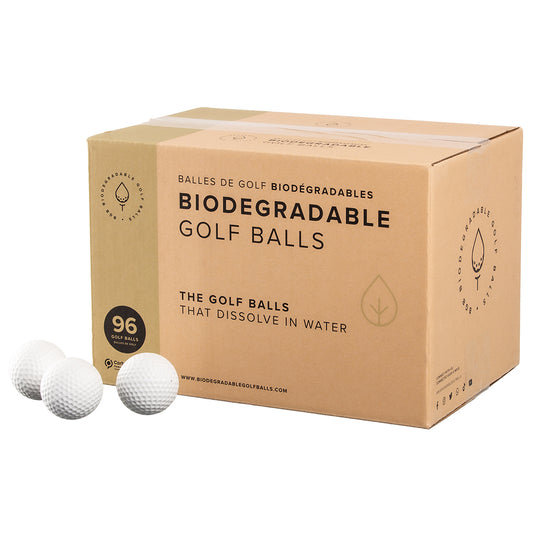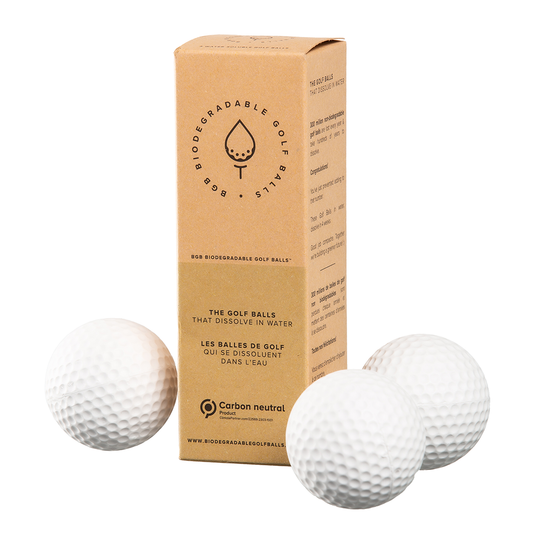Why Are There Dimples on Golf Balls?
Our 24-pack of golf balls is no exception! We rock the dimples!
Have you ever wondered why golf balls have all those little bumps (more commonly referred to as “dimples”) all over them? Well, today’s post takes a look at why and how these “dimples” came to be. There is a lot of incredible history and tech behind the little dimples on golf balls.
Brief History of Golf Balls Having Dimples
Believe it or not, golf balls weren’t always covered in dimples. Here’s how this game-changing feature came to be:
- The Smooth Beginnings: Early golf balls were made of wood, leather, or rubber, and were completely smooth. No one realized their design was holding them back!
- A Happy Accident: Golfers discovered that older, scuffed-up balls flew farther than shiny, new ones. The texture created extra lift and reduced drag, giving players an unexpected advantage.
- Crafting the First Dimples: Manufacturers jumped on the trend, hiring craftsmen to hand-carve dimples into every ball. These early designs were crude but revolutionary.
- A New Standard: Once the benefits of dimples became clear, smooth golf balls became a thing of the past. Today, dimples are a carefully engineered feature on every golf ball to maximize performance.
How Are The Dimples On A Golf Ball Made?
The development of dimples started with people hand carving them before the introduction of the golf ball mould. This removed the extra step of adding dimples and the next leap in dimple tech adds this step back in with laser etching. For aesthetic purposes, many companies also adopted printing on the dimpled balls, which also helped golfers determine which ball belonged to them.
Hand-Carved Early Dimples:
The first dimples were hand-carved into the balls. Basic and tried to mimic the regular wear and tear of a smooth golf ball.
They lacked any real consistency or testing. By engaging in a lot of competitive games players started to notice which patterns were better and pushed the evolution of dimple design. This method was tedious, expensive and time-consuming but it made enough of a difference that it kept on.
Moulds For Modern Dimple Formation:
Most balls in the last hundred years were made in moulds. Moulds removed the need to manually add dimples after the ball is made. It also means the pattern will be the same every time that a particular mould is used. The use of moulds to make balls with dimples persists today. The dimple pattern is part of the mold is easily adjusted which allows different patterns to be tested. The modern plastics that golf balls are made from are the perfect match for modern plastic moulding. This process has been refined over the years to bring a performance-dimpled ball to the masses.
Laser Precision Brings Us Back:
Laser technology has recently been integrated into golf ball manufacturing, offering precise control over dimple patterns and allowing tailored designs. This innovation optimizes aerodynamics and customizes performance for various playing conditions and preferences. Lasers are used to cut precise dimples that moulds cannot. We went back to adding the dimples to the balls with modern tech.
The Science Behind Having Dimples on Golf Balls
The Secret Behind Golf Ball Dimples
Ever wonder why golf balls have dimples? Let’s dive into the science that makes these little bumps a performance game-changer.
How Dimples Work
-
Reduced Drag: Dimples cut down on drag, the enemy of distance. A dimpled golf ball has 50% less drag compared to a smooth one, letting it fly farther.
-
Tiny Turbulences: Each of the ~500 dimples on a golf ball creates a thin layer of turbulence, allowing air to flow more smoothly around the ball and reducing resistance.
-
Enhanced Performance: Advanced dimple designs further optimize lift and reduce drag, helping players achieve longer, straighter shots.
Smooth vs. Dimpled: A Quick Comparison
-
Smooth Ball: Creates no turbulence, leading to unstable air at the back of the ball and shorter flight.
-
Dimpled Ball: Generates controlled turbulences, improving air stability and maximizing distance.
See the Science in Action
Golf scientist Steve Quintavalla explained this phenomenon on NBC News Learn. Check out the video for a deeper look into how dimples revolutionized the game!
Dimples aren’t just for show—they’re the aerodynamic secret behind every great shot. Ready to up your game? Choose a ball that flies farther and performs better!
The Advancement of Dimple Science and Development
The field of dimple science became a thing in the 1950s as golf ball dimple design underwent significant developments that changed the game. The big sports equipment names you know today (Titleist, Spalding, Wilson, Dunlop, & Hogan) were actively engaged in research and development to enhance golf ball dimple design. They all fought each other to be crowned king of the ball and advanced dimple designs to aerodynamics and ball performance. Analog testing method breakthroughs like the wind tunnel allowed them to fine-tune the design.
Modern advances in testing the dimple pattern evolved alongside the materials used to make a golf ball and include digital testing, precise measurements, computer design and controlled robotic trials. This evolution in dimple design reflects how the golf industry has constantly strived to improve the performance of golf balls, making the game more enjoyable and accessible for players of all skill levels.
TL;DR
- Dimples on golf balls came about as they travelled faster and further than a golf ball with a smooth exterior
- Golfers gradually started to realize this and opted to use older golf balls that had bumps all over them.
- Golf ball manufacturers followed the trend and began producing and selling dimpled golf balls.
- Dimpled golf balls became the new norm, rendering golf balls with smooth exteriors to be discontinued.
- Dimpled golf balls travel faster than smooth golf ball as it creates turbulences that allows for more stable flowing air on the back of the ball.
- With more stable air on the back of a golf ball, the drag force on the motion of the golf ball is reduced, hence, allowing it to fly further and faster.
- A dimpled golf ball has half the drag of a golf ball with a smooth exterior.
Little Details | Big Differences!
Just like the little dimples on a golf ball make a big difference in performance, the small choices we make can have a huge impact on the environment. Traditional golf balls contribute to long-term pollution, but biodegradable golf balls break down safely, leaving no harm behind. Ready to make a difference with every swing? Shop our biodegradable golf balls today and join the movement to keep our planet green—one dimple at a time!"







